Abstract
CD14 is a differentiation-stage-linked glycosyl-phophatidyl-inositol-linked glycoprotein on human peripheral blood monocytes and tissue macrophages, which functions as a receptor for lipopolysaccharide. Here, the effects of granulocyte macrophage colony-stimulating factor (GM-CSF1 a cytokine with proliferation- and differentiation-inducing properties on myeloid lineage cells, were studied on CD14 expression by peripheral blood cells. GM-CSF down-regulated the membrane expression of CD14 on monocytes while it up-regulated expression on neutrophils. GM-CSF also decreased the spontaneous release of CD14 in monocyte culture supernatants. Down-regulation of CD14 expression and release was accompanied by a decrease in the mRNA transcript for CD14, suggesting that it most likely reflects an effect on the transcriptional level. The functional significance of this phenomenon, and its potential relation to the terminal differentiation of monocytes, are discussed.
Full text
PDF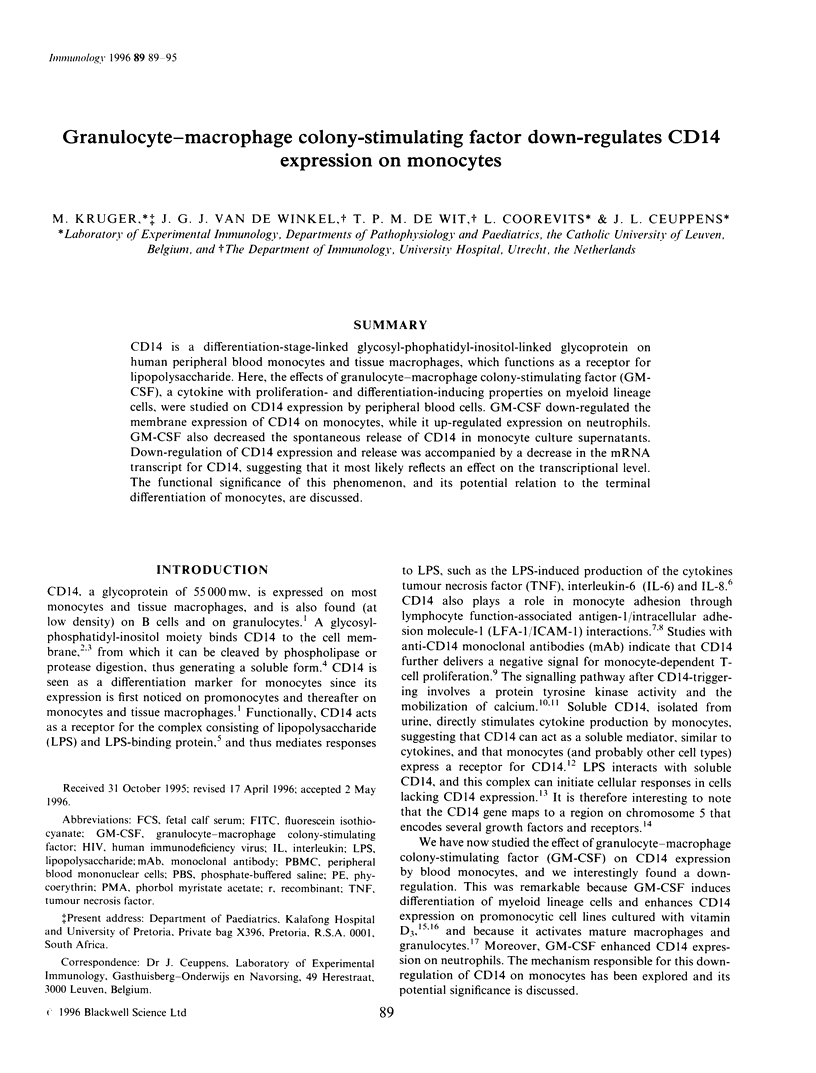

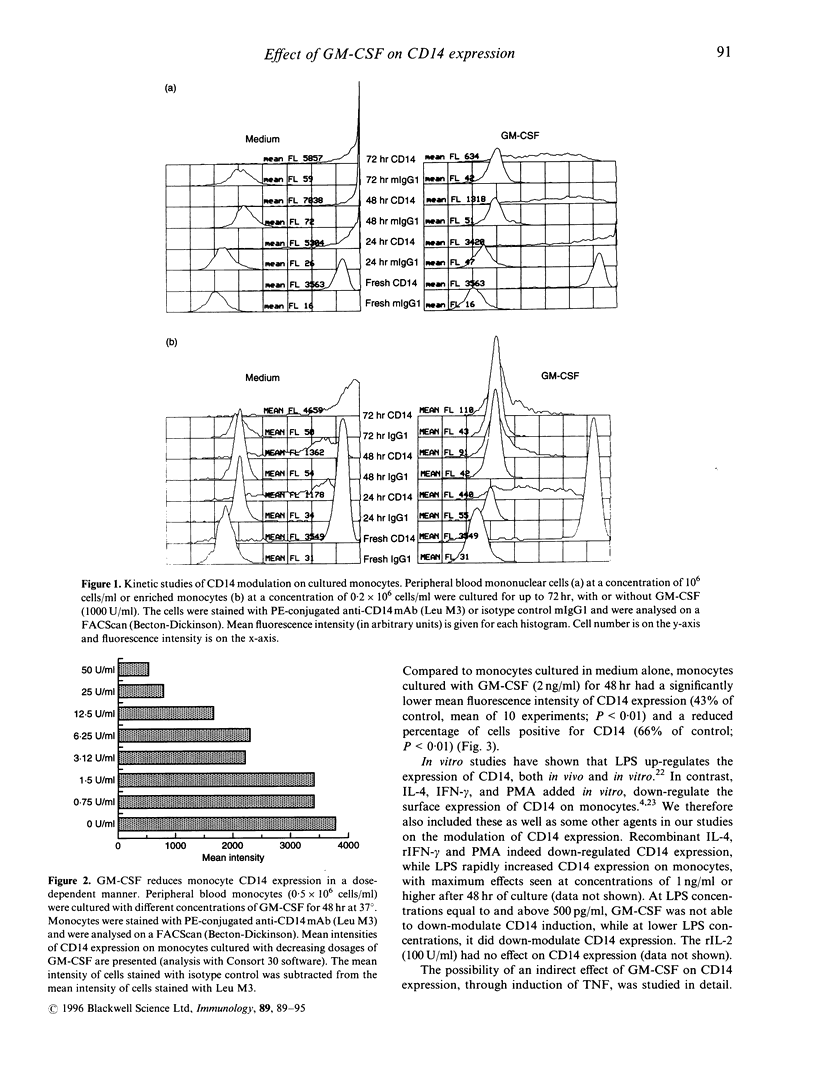
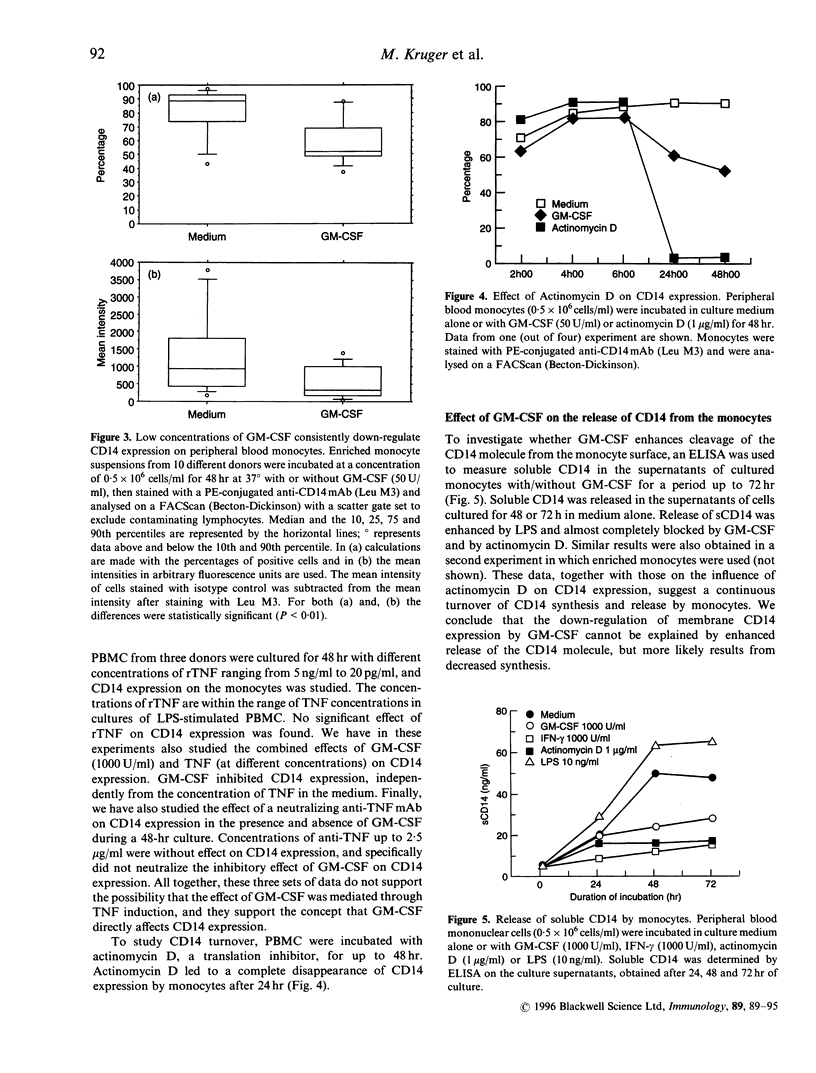

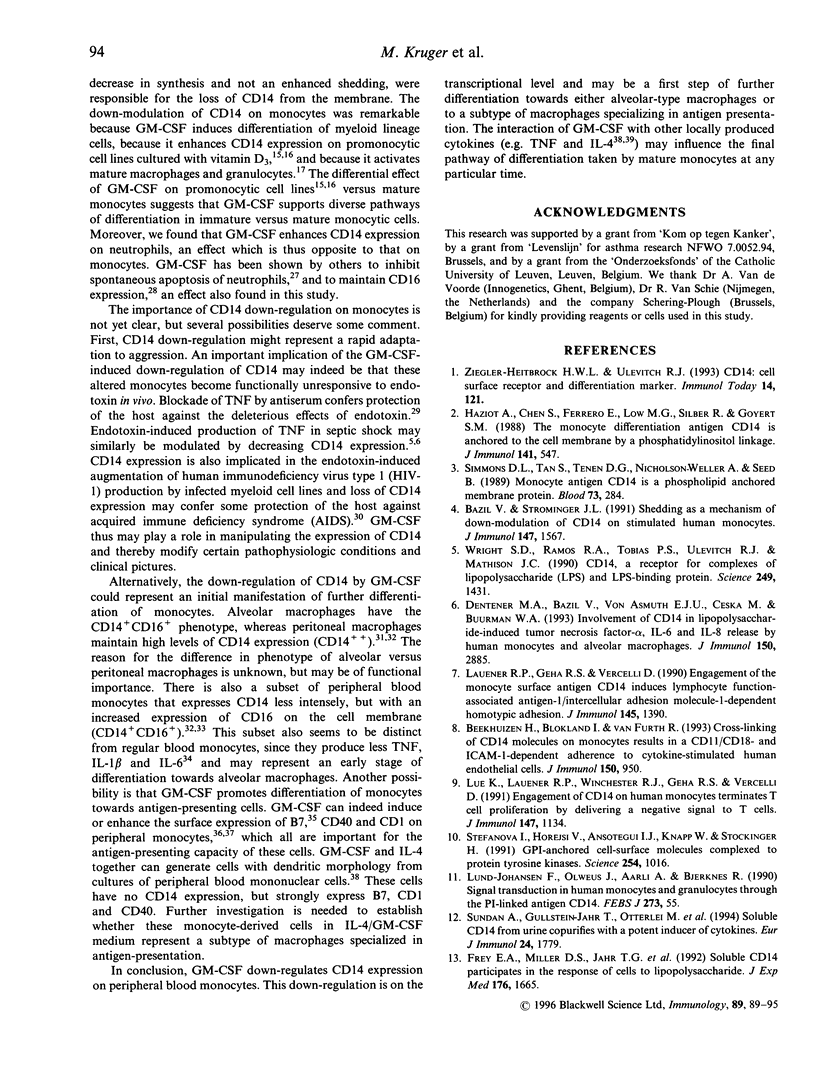
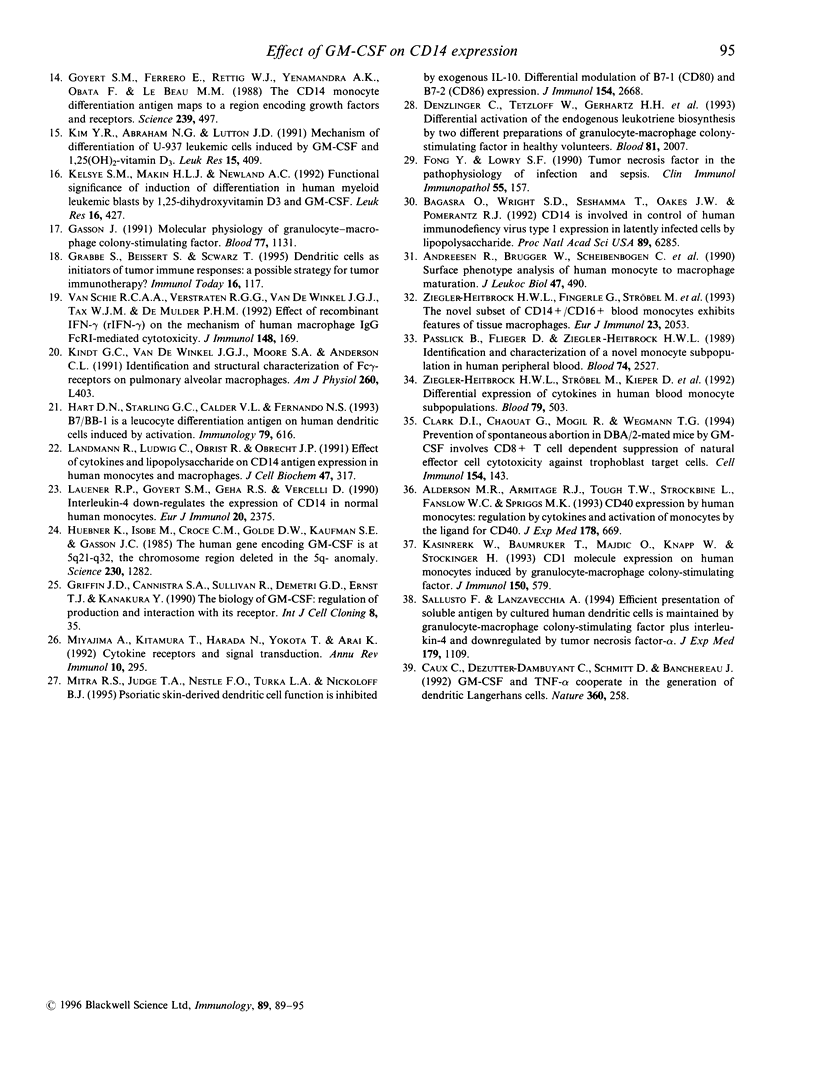
Images in this article
Selected References
These references are in PubMed. This may not be the complete list of references from this article.
- Alderson M. R., Armitage R. J., Tough T. W., Strockbine L., Fanslow W. C., Spriggs M. K. CD40 expression by human monocytes: regulation by cytokines and activation of monocytes by the ligand for CD40. J Exp Med. 1993 Aug 1;178(2):669–674. doi: 10.1084/jem.178.2.669. [DOI] [PMC free article] [PubMed] [Google Scholar]
- Andreesen R., Brugger W., Scheibenbogen C., Kreutz M., Leser H. G., Rehm A., Löhr G. W. Surface phenotype analysis of human monocyte to macrophage maturation. J Leukoc Biol. 1990 Jun;47(6):490–497. doi: 10.1002/jlb.47.6.490. [DOI] [PubMed] [Google Scholar]
- Bagasra O., Wright S. D., Seshamma T., Oakes J. W., Pomerantz R. J. CD14 is involved in control of human immunodeficiency virus type 1 expression in latently infected cells by lipopolysaccharide. Proc Natl Acad Sci U S A. 1992 Jul 15;89(14):6285–6289. doi: 10.1073/pnas.89.14.6285. [DOI] [PMC free article] [PubMed] [Google Scholar]
- Bazil V., Strominger J. L. Shedding as a mechanism of down-modulation of CD14 on stimulated human monocytes. J Immunol. 1991 Sep 1;147(5):1567–1574. [PubMed] [Google Scholar]
- Beekhuizen H., Blokland I., van Furth R. Cross-linking of CD14 molecules on monocytes results in a CD11/CD18- and ICAM-1-dependent adherence to cytokine-stimulated human endothelial cells. J Immunol. 1993 Feb 1;150(3):950–959. [PubMed] [Google Scholar]
- Caux C., Dezutter-Dambuyant C., Schmitt D., Banchereau J. GM-CSF and TNF-alpha cooperate in the generation of dendritic Langerhans cells. Nature. 1992 Nov 19;360(6401):258–261. doi: 10.1038/360258a0. [DOI] [PubMed] [Google Scholar]
- Clark D. A., Chaouat G., Mogil R., Wegmann T. G. Prevention of spontaneous abortion in DBA/2-mated CBA/J mice by GM-CSF involves CD8+ T cell-dependent suppression of natural effector cell cytotoxicity against trophoblast target cells. Cell Immunol. 1994 Mar;154(1):143–152. doi: 10.1006/cimm.1994.1064. [DOI] [PubMed] [Google Scholar]
- Dentener M. A., Bazil V., Von Asmuth E. J., Ceska M., Buurman W. A. Involvement of CD14 in lipopolysaccharide-induced tumor necrosis factor-alpha, IL-6 and IL-8 release by human monocytes and alveolar macrophages. J Immunol. 1993 Apr 1;150(7):2885–2891. [PubMed] [Google Scholar]
- Denzlinger C., Tetzloff W., Gerhartz H. H., Pokorny R., Sagebiel S., Haberl C., Wilmanns W. Differential activation of the endogenous leukotriene biosynthesis by two different preparations of granulocyte-macrophage colony-stimulating factor in healthy volunteers. Blood. 1993 Apr 15;81(8):2007–2013. [PubMed] [Google Scholar]
- Fong Y., Lowry S. F. Tumor necrosis factor in the pathophysiology of infection and sepsis. Clin Immunol Immunopathol. 1990 May;55(2):157–170. doi: 10.1016/0090-1229(90)90094-7. [DOI] [PubMed] [Google Scholar]
- Frey E. A., Miller D. S., Jahr T. G., Sundan A., Bazil V., Espevik T., Finlay B. B., Wright S. D. Soluble CD14 participates in the response of cells to lipopolysaccharide. J Exp Med. 1992 Dec 1;176(6):1665–1671. doi: 10.1084/jem.176.6.1665. [DOI] [PMC free article] [PubMed] [Google Scholar]
- Gasson J. C. Molecular physiology of granulocyte-macrophage colony-stimulating factor. Blood. 1991 Mar 15;77(6):1131–1145. [PubMed] [Google Scholar]
- Goyert S. M., Ferrero E., Rettig W. J., Yenamandra A. K., Obata F., Le Beau M. M. The CD14 monocyte differentiation antigen maps to a region encoding growth factors and receptors. Science. 1988 Jan 29;239(4839):497–500. doi: 10.1126/science.2448876. [DOI] [PubMed] [Google Scholar]
- Grabbe S., Beissert S., Schwarz T., Granstein R. D. Dendritic cells as initiators of tumor immune responses: a possible strategy for tumor immunotherapy? Immunol Today. 1995 Mar;16(3):117–121. doi: 10.1016/0167-5699(95)80125-1. [DOI] [PubMed] [Google Scholar]
- Griffin J. D., Cannistra S. A., Sullivan R., Demetri G. D., Ernst T. J., Kanakura Y. The biology of GM-CSF: regulation of production and interaction with its receptor. Int J Cell Cloning. 1990 Jan;8 (Suppl 1):35–45. doi: 10.1002/stem.5530080705. [DOI] [PubMed] [Google Scholar]
- Hart D. N., Starling G. C., Calder V. L., Fernando N. S. B7/BB-1 is a leucocyte differentiation antigen on human dendritic cells induced by activation. Immunology. 1993 Aug;79(4):616–620. [PMC free article] [PubMed] [Google Scholar]
- Haziot A., Chen S., Ferrero E., Low M. G., Silber R., Goyert S. M. The monocyte differentiation antigen, CD14, is anchored to the cell membrane by a phosphatidylinositol linkage. J Immunol. 1988 Jul 15;141(2):547–552. [PubMed] [Google Scholar]
- Huebner K., Isobe M., Croce C. M., Golde D. W., Kaufman S. E., Gasson J. C. The human gene encoding GM-CSF is at 5q21-q32, the chromosome region deleted in the 5q- anomaly. Science. 1985 Dec 13;230(4731):1282–1285. doi: 10.1126/science.2999978. [DOI] [PubMed] [Google Scholar]
- Kasinrerk W., Baumruker T., Majdic O., Knapp W., Stockinger H. CD1 molecule expression on human monocytes induced by granulocyte-macrophage colony-stimulating factor. J Immunol. 1993 Jan 15;150(2):579–584. [PubMed] [Google Scholar]
- Kelsey S. M., Makin H. L., Newland A. C. Functional significance of induction of differentiation in human myeloid leukaemic blasts by 1,25-dihydroxyvitamin D3 and GM-CSF. Leuk Res. 1992;16(5):427–434. doi: 10.1016/0145-2126(92)90167-6. [DOI] [PubMed] [Google Scholar]
- Kim Y. R., Abraham N. G., Lutton J. D. Mechanisms of differentiation of U937 leukemic cells induced by GM-CSF and 1,25(OH)2 vitamin D3. Leuk Res. 1991;15(6):409–418. doi: 10.1016/0145-2126(91)90050-4. [DOI] [PubMed] [Google Scholar]
- Kindt G. C., van de Winkel J. G., Moore S. A., Anderson C. L. Identification and structural characterization of Fc gamma-receptors on pulmonary alveolar macrophages. Am J Physiol. 1991 Jun;260(6 Pt 1):L403–L411. doi: 10.1152/ajplung.1991.260.6.L403. [DOI] [PubMed] [Google Scholar]
- Landmann R., Ludwig C., Obrist R., Obrecht J. P. Effect of cytokines and lipopolysaccharide on CD14 antigen expression in human monocytes and macrophages. J Cell Biochem. 1991 Dec;47(4):317–329. doi: 10.1002/jcb.240470406. [DOI] [PubMed] [Google Scholar]
- Lauener R. P., Geha R. S., Vercelli D. Engagement of the monocyte surface antigen CD14 induces lymphocyte function-associated antigen-1/intercellular adhesion molecule-1-dependent homotypic adhesion. J Immunol. 1990 Sep 1;145(5):1390–1394. [PubMed] [Google Scholar]
- Lauener R. P., Goyert S. M., Geha R. S., Vercelli D. Interleukin 4 down-regulates the expression of CD14 in normal human monocytes. Eur J Immunol. 1990 Nov;20(11):2375–2381. doi: 10.1002/eji.1830201103. [DOI] [PubMed] [Google Scholar]
- Lue K. H., Lauener R. P., Winchester R. J., Geha R. S., Vercelli D. Engagement of CD14 on human monocytes terminates T cell proliferation by delivering a negative signal to T cells. J Immunol. 1991 Aug 15;147(4):1134–1138. [PubMed] [Google Scholar]
- Lund-Johansen F., Olweus J., Aarli A., Bjerknes R. Signal transduction in human monocytes and granulocytes through the PI-linked antigen CD14. FEBS Lett. 1990 Oct 29;273(1-2):55–58. doi: 10.1016/0014-5793(90)81049-t. [DOI] [PubMed] [Google Scholar]
- Miyajima A., Kitamura T., Harada N., Yokota T., Arai K. Cytokine receptors and signal transduction. Annu Rev Immunol. 1992;10:295–331. doi: 10.1146/annurev.iy.10.040192.001455. [DOI] [PubMed] [Google Scholar]
- Passlick B., Flieger D., Ziegler-Heitbrock H. W. Identification and characterization of a novel monocyte subpopulation in human peripheral blood. Blood. 1989 Nov 15;74(7):2527–2534. [PubMed] [Google Scholar]
- Sallusto F., Lanzavecchia A. Efficient presentation of soluble antigen by cultured human dendritic cells is maintained by granulocyte/macrophage colony-stimulating factor plus interleukin 4 and downregulated by tumor necrosis factor alpha. J Exp Med. 1994 Apr 1;179(4):1109–1118. doi: 10.1084/jem.179.4.1109. [DOI] [PMC free article] [PubMed] [Google Scholar]
- Simmons D. L., Tan S., Tenen D. G., Nicholson-Weller A., Seed B. Monocyte antigen CD14 is a phospholipid anchored membrane protein. Blood. 1989 Jan;73(1):284–289. [PubMed] [Google Scholar]
- Stefanová I., Horejsí V., Ansotegui I. J., Knapp W., Stockinger H. GPI-anchored cell-surface molecules complexed to protein tyrosine kinases. Science. 1991 Nov 15;254(5034):1016–1019. doi: 10.1126/science.1719635. [DOI] [PubMed] [Google Scholar]
- Sundan A., Gullstein-Jahr T., Otterlei M., Ryan L., Bazil V., Wright S. D., Espevik T. Soluble CD14 from urine copurifies with a potent inducer of cytokines. Eur J Immunol. 1994 Aug;24(8):1779–1784. doi: 10.1002/eji.1830240809. [DOI] [PubMed] [Google Scholar]
- Van Schie R. C., Verstraten R. G., Van de Winkel J. G., Tax W. J., de Mulder P. H. Effect of recombinant IFN-gamma (rIFN-gamma) on the mechanism of human macrophage IgG FcRI-mediated cytotoxicity. rIFN-gamma decreases inhibition by cytophilic human IgG and changes the cytolytic mechanism. J Immunol. 1992 Jan 1;148(1):169–176. [PubMed] [Google Scholar]
- Wright S. D., Ramos R. A., Tobias P. S., Ulevitch R. J., Mathison J. C. CD14, a receptor for complexes of lipopolysaccharide (LPS) and LPS binding protein. Science. 1990 Sep 21;249(4975):1431–1433. doi: 10.1126/science.1698311. [DOI] [PubMed] [Google Scholar]
- Ziegler-Heitbrock H. W., Fingerle G., Ströbel M., Schraut W., Stelter F., Schütt C., Passlick B., Pforte A. The novel subset of CD14+/CD16+ blood monocytes exhibits features of tissue macrophages. Eur J Immunol. 1993 Sep;23(9):2053–2058. doi: 10.1002/eji.1830230902. [DOI] [PubMed] [Google Scholar]
- Ziegler-Heitbrock H. W., Ströbel M., Kieper D., Fingerle G., Schlunck T., Petersmann I., Ellwart J., Blumenstein M., Haas J. G. Differential expression of cytokines in human blood monocyte subpopulations. Blood. 1992 Jan 15;79(2):503–511. [PubMed] [Google Scholar]
- Ziegler-Heitbrock H. W., Ulevitch R. J. CD14: cell surface receptor and differentiation marker. Immunol Today. 1993 Mar;14(3):121–125. doi: 10.1016/0167-5699(93)90212-4. [DOI] [PubMed] [Google Scholar]



